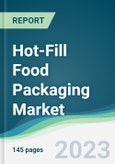The Hot-Fill Food packaging market is estimated to grow at a CAGR of 4.71% during the forecast period.
Hot-fill food packaging refers to a packaging method commonly used for products that are filled at high temperatures, typically above 85°C (185°F), into containers that can withstand thermal stress. This process involves filling the product while it is still hot and then sealing the container to create a hermetic seal. The hot-fill method is often employed for liquid or viscous food products, such as juices, sauces, soups, and beverages, as it helps preserve the product's flavor, quality, and nutritional value. The high temperature during filling eliminates or reduces the need for additional preservatives, and the subsequent sealing prevents microbial contamination and extends the shelf life of the packaged food.Introduction:
The hot-fill food packaging market refers to the industry involved in manufacturing and supplying packaging solutions specifically designed for hot-fill food products. This market caters to the increasing demand for convenient, ready-to-consume food and beverages that require high-temperature filling to ensure product safety, quality, and preservation. The market encompasses a range of packaging materials, such as bottles, jars, pouches, and cartons that can withstand the thermal stress of hot-filling processes.Factors driving the hot-fill food packaging market include the growing popularity of on-the-go lifestyles, the demand for extended shelf life without the need for preservatives, and the rising consumption of hot-filled products such as juices, sauces, soups, and ready-to-drink beverages. The market is focused on developing innovative and sustainable packaging solutions that meet consumer preferences while ensuring product integrity.
Drivers:
- Increasing Demand for Convenient On-the-Go Products:
- Growing Popularity of Ready-to-Drink Beverages:
- Extended Shelf Life without Preservatives:
- Enhanced Product Safety:
- Protection of Product Quality and Nutritional Value:
- Increasing Demand for Sustainable Packaging:
- Product Differentiation and Shelf Appeal:
- Market Expansion in Developing Economies:
- Convenience for Foodservice Industry:
- Technological Advancements in Packaging Materials:
Products offered by key companies:
- Tetra Paklaunched a new line of hot-fill cartons made from 100% renewable materials. The new cartons are made from a combination of paperboard, polyethene, and sugarcane-based plastic.
- Huhtamakilaunched a new line of hot-fill cups made from a combination of paperboard and PLA. The new cups are compostable and have a lower carbon footprint than traditional plastic cups.
- Campbell Soup Companylaunched a new line of hot-fill soups in packaging made from a combination of paperboard and PLA. The new packaging is compostable and has a lower carbon footprint than traditional plastic packaging.
Positive growth in the flexible packaging segment:
The segment of flexible packaging is witnessing significant growth within the hot-fill food packaging market. This growth can be attributed to several factors. Flexible packaging offers numerous advantages such as lightweight, cost-effectiveness, and the ability to accommodate various product shapes and sizes. Additionally, advancements in flexible packaging materials, such as high-temperature-resistant films and laminates, have enhanced their suitability for hot-fill applications. Moreover, the rising demand for convenience and on-the-go consumption has led to an increased preference for flexible packaging formats like pouches and stand-up pouches, which are convenient for hot-fill products. These factors contribute to the positive growth and adoption of flexible packaging in the hot-fill food packaging market.The Asia-Pacific region is expected to hold a significant share:
The Asia-Pacific region is projected to dominate the hot-fill food packaging market due to rising demand for hot-filled food products, emphasis on food safety and quality, and the presence of major food and beverage companies. Factors such as a growing middle class, urbanization, and awareness of health benefits are driving the demand for convenient and processed foods. Additionally, the region has stringent food safety regulations, prompting the need for reliable hot-fill food packaging solutions. Key markets in the Asia-Pacific region include China, India, Japan, South Korea, and Indonesia.Key developments:
- In January 2023,Mespack and Hoffer Plastics introduced a new spout and cap closure called P-15 for stand-up pouches. The closure is designed to be compatible with both monolayer materials and Mespack's form-fill-seal machines. The P-15 is lightweight and uses 20% less plastic compared to previous designs.
- In May 2022,Berry Global launched a new line of user-friendly hot fill sauce bottles called Nova. These bottles are made from clear polypropylene (PP) using co-extrusion blow molding technology. The Nova bottles are designed for both top-down and upright use and come with 38/400 flip-top closures in valved and valveless options.
Key Segments:
By Packaging Material Type
- Plastic
- Glass
- Other
By Product Type
- Bottles
- Jars
- Pouches
- Cups and Tubs
- Others
By Application
- Sauces and Condiments
- Processed Food and Vegetables
- Others
By Geography
- North America
- United States
- Canada
- Mexico
- South America
- Brazil
- Argentina
- Others
- Europe
- United Kingdom
- Germany
- France
- Italy
- Spain
- Others
- Middle East and Africa
- Saudi Arabia
- UAE
- Others
- Asia Pacific
- Japan
- China
- India
- South Korea
- Taiwan
- Thailand
- Indonesia
- Others
Table of Contents
Companies Mentioned
- Amcor Plc
- San Miguel Yamamura Packaging Corporation
- Berry Global Inc.
- Crown Holdings Inc.
- Scholle IPN Corporation
- Graham Packaging Company
- MJS Packaging
- Imperial Packaging
- Novolex
- The Cary Company








